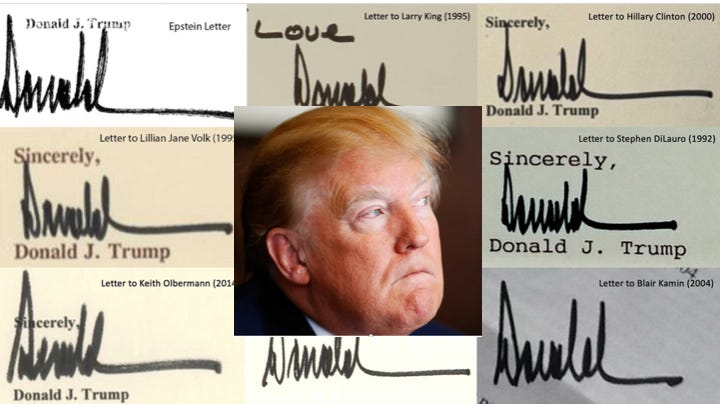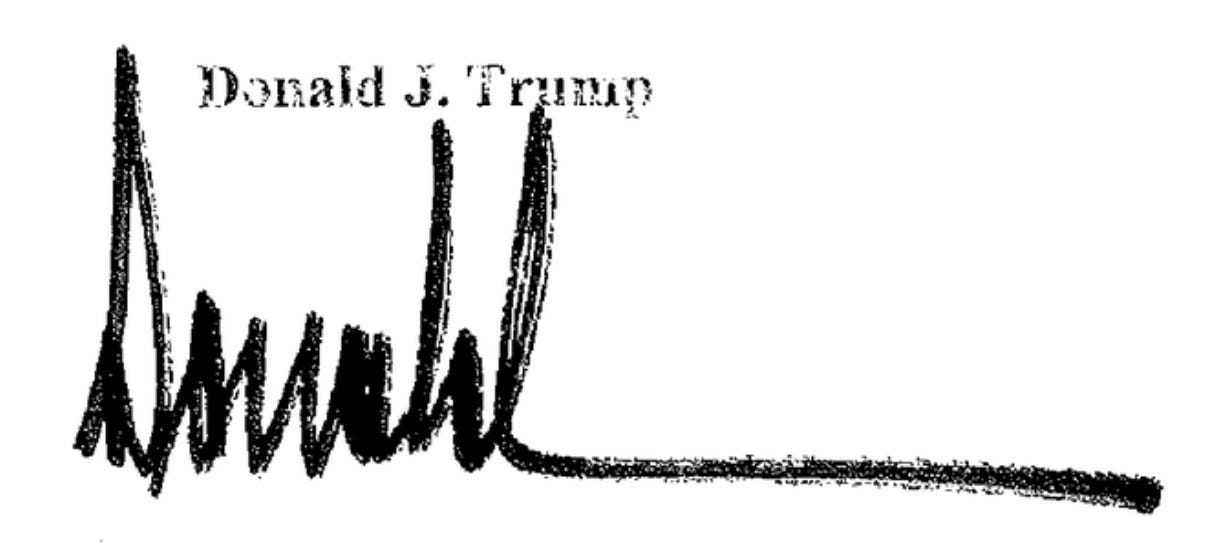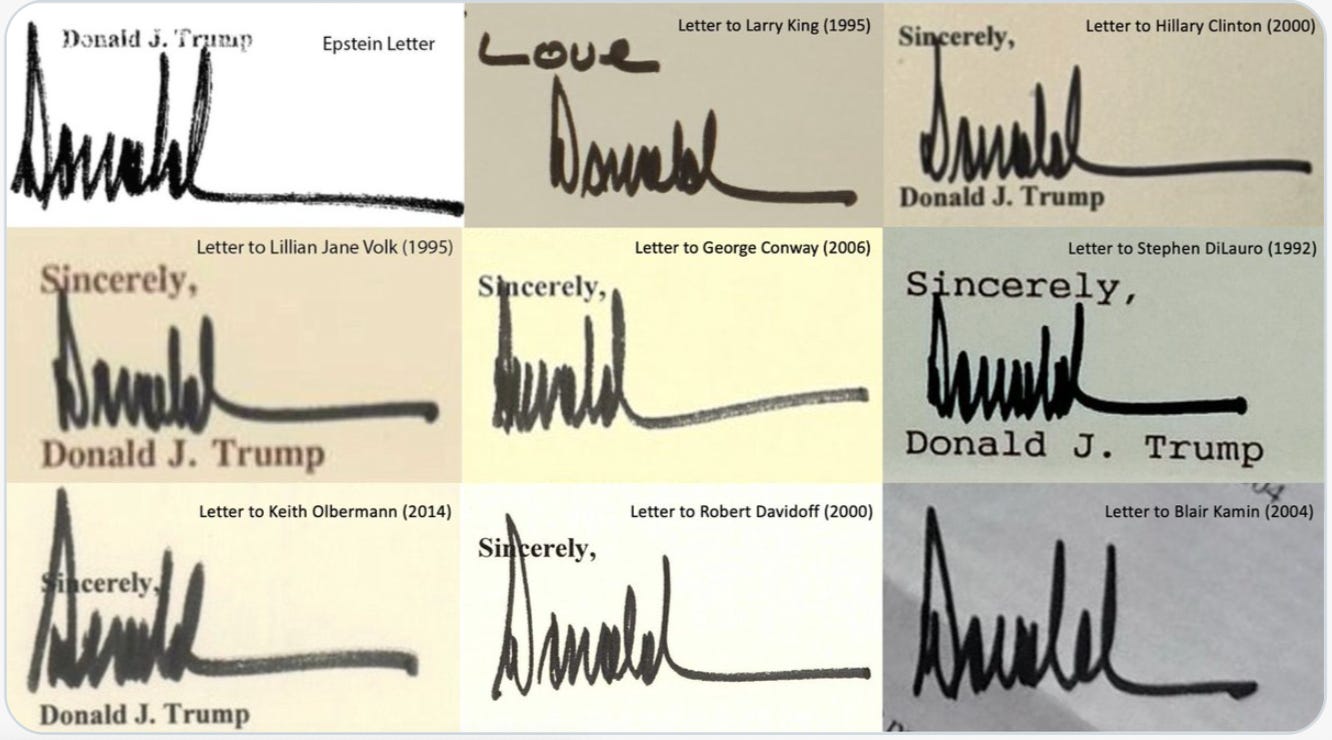A Deeper Look at Trump’s Signature by a CIA Officer with Graphology/Forensic Document Examination Training
In my CIA days I worked a number of times with graphologists, who were considered to be a valid source of psychological insight into someone we might be looking at to recruit, or a foreign leader. I even took a course in it. Forensic examination was part of it too — detecting forgery. That doesn’t make me an official forensic document examiner by any stretch — but perhaps the following observations will be helpful.
The Signature — Obtaining Useful Samples
So…here is the signature on the birthday book.
The disputed signature in the Epstein “birthday book” is simply “Donald” with a long horizontal line.
Signatures change in subtle ways over time, so the most useful comparables are from the same general time period as the 2003 birthday card. And ideally, they should also be just “Donald,” not the full “Donald J. Trump.”
Here is a useful compilation of comparable signatures from the 1990s–2000s:
Initial Impressions
At first glance, the Epstein signature displays the same skyline-like jagged peaks, the compressed cluster of verticals, and the long trailing underline seen in Trump’s signatures throughout the 1990s and 2000s. It shows confidence and fluency — strokes executed quickly without tremor.
The overall rhythm and silhouette are immediately recognizable as consistent with Trump’s known signature.
Drilling Down in Search of Forgery
When looking for signs of forgery, examiners focus on several hallmarks:
Tremor or shakiness — caused by slow, deliberate imitation.
Unnatural pen lifts or stops — hesitation where the genuine signer would flow continuously.
Uniform pressure — forgeries often lack the natural variation between heavy downstrokes and lighter upstrokes.
Disproportionate strokes — exaggerated peaks, oddly short or long segments.
Over-consistency — forgeries may look too neat or mechanical compared to natural variation.
Are Any Hallmarks of Forgery Present?
With the caveat that we don’t have the original and are working off a scan — the Epstein signature does not exhibit tremor, hesitation, or uniform pressure. Its lines are bold and fluid, with heavy downstrokes and lighter connections. The proportions are consistent with Trump’s authentic autographs.
In short: the classic warning signs of forgery are absent.
Does the Signature “Match” Within Normal Variations?
Yes. The Epstein signature falls well within the natural range of variation seen in Trump’s genuine signatures from the 1990s–2000s.
It is not an exact duplicate of any one known sample — which is important. A traced or mechanically reproduced forgery would look suspiciously identical. Instead, this signature looks like one of many natural iterations, displaying the same “DNA” of Trump’s autograph while differing slightly in density and spacing.
What Would Be the Best Argument for Forgery?
There really isn’t a strong one. The absence of forgery hallmarks makes the case for fabrication weak. The only theoretical arguments would be:
Contextual oddity — appearing in a birthday book with a nude sketch is unusual for Trump’s normal signing environment.
Signature density — the peaks are slightly more tightly clustered than in some other examples.
But these points don’t outweigh the stylistic consistency.
Conclusion
Caveats are necessary. As noted above, we are working from a scan, not the original document. The quality of reproduction limits what can be seen about pen pressure, ink flow, and microscopic features. Only a certified forensic document examiner with access to the original could render a definitive opinion. That said, based on the available evidence, the probability that the Epstein birthday book signature is authentic is very high. It lacks forgery hallmarks, matches Trump’s known signature traits from the same era, and falls squarely within the natural range of variation.
==============================================================
Thanks again to everyone for your support. The last few days have seen a number of new subscribers, both paid and free, and it’s a shot in the arm when that happens. Please know that your subscriptions truly help. Also know that it helps when you go to your dashboard and “Recommend” Deeper Look using the recommend function there. Thanks again!





A forensic specialist in questioned documents is known as a document examiner. A graphologist not generally viewed in the legal world in the same way. Graphologists claim to be able to decipher writers psychology and emotions from handwriting. So far scientific proof of that is elusive.
EJ Wagner, author of The Science of Sherlock Holmes,” former moderator of Forensic Forum at SUNY Stony Brook
Can you give us a reading on Trump’s personality profile based on his very unusual signature? Would be appreciated.